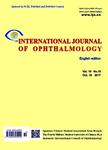Use of intra-arterial chemotherapy for retinoblastoma:results of a survey
Use of intra-arterial chemotherapy for retinoblastoma:results of a survey作者机构:Department of Pediatric Oncology Instituto Nacional de Cncer Ophthalmic Oncology Service Instituto Nacional de Cncer Oncology Service Hospital Sant Joan de Deu Esplugues de Llobregat Ophthalmology Service Hospital Sant Joan de DeuEsplugues de Llobregat
出 版 物:《International Journal of Ophthalmology(English edition)》 (国际眼科杂志(英文版))
年 卷 期:2014年第7卷第4期
页 面:726-730页
核心收录:
学科分类:1002[医学-临床医学] 100214[医学-肿瘤学] 10[医学]
基 金:Supported in part by the Fund for Ophthalmic Knowledge (New York, USA) the Natali Dafne Flexer (Buenos Aires, Argentina)
主 题:retinoblastoma intra-arterial chemotherapy survey
摘 要:·AIM: To obtain baseline knowledge about the current use of intra-arterial chemotherapy(SSOAIC) in centers worldwide.·METHODS: A survey including questions about the use of SSOAIC was emailed to retinoblastoma experts.·RESULTS:Seventy-nine(response rate 69.9%) doctors from 63 centers in 35 countries responded. Thirty-one centers from 19 countries use SSOAIC. Twelve performed more than 50 procedures. Melphalan is the most commonly used drug but 15 centers use more than one drug. First line therapy for advanced unilateral disease is the most common use of SSOAIC(74.2%). Centers with larger experience(50 applications) were less likely using melphalan alone(P =0.06) and significantly more likely using SSOAIC in more situations such as second line in preference to radiotherapy P =0.05. Nineteen(61.2%)stated that SSOAIC improved their results and 21(77.8%)reported less toxicity compared to other *** centers reported that SSOAIC did not improve their results. There were regional variations in the use of SSOAIC which is used more frequently as secondary treatment in Europe compared to the USA and *** centers identified cost is the major limiting factor for SSOAIC.· CONCLUSION: SSOAIC is used in an increasing number of centers worldwide with regional *** with more experience in SSOAIC use it in more situations including other drugs than melphalan. The majority of the centers using this technique reportedimproved results and few complications.



